Chickpeas are one of the most consumed legumes in the world. You can buy dried chickpeas from the market or canned ones. But they hold tremendous differences.
So, which one is better between Dried Chickpeas and Canned Chickpeas?
Dried chickpeas are better in terms of taste and nutrition than canned chickpeas. Canned chickpeas lose nutrient values as it’s processed with additives, salts, and other chemicals. However, dried chickpeas don’t. When it’s soaked and fully hydrated it provides the full nutrient benefits.
Curious to know further about their health benefits, nutrition facts, and taste differences? Then join us in the full discussion.
What Are Chickpeas?
Chickpeas also known as garbanzo beans are a type of legume that are high in protein and fiber. They also go by the name Bengal gram, gram, and Egyptian pea.
Aside from protein they are high with many other nutrients as well. You’ll find two types of chickpeas. One is large in size and light-colored that are most common in the US.
The smaller ones are dark-colored and have irregular shapes. They are found in the Middle East and India. These chickpeas are sold both in dried or canned condition.
Both canned and dried chickpeas are used in multiple recipes for chickpeas.
Dried Chickpeas:
Dried chickpeas are wonderful whole foods since they are unprocessed and directly come from the ground. It contains no preservatives, salt, or chemicals.
You can find them in bulk in superstores or in cheap grocery stores. They can be stored in air-tight containers for about a year. However, the longer it stays the harder it gets due to hydration loss.
Canned Chickpeas:
Canned chickpeas are pre-cooked and pre-seasoned most of the time. They can be served right out of the can. But before that, it’s better to rinse them well to get rid of bean juice, additives, or extra salts.
Quick Overview: Dried Chickpeas Vs Canned Chickpeas
As you can guess, the main difference between dried chickpeas and canned ones lies in the nutritional benefits. But from processing to cooking you’ll find many other dissimilarities too.
Here we’ve listed them down. These are the fundamental differences between both.
| Comparison Factor | Dried Chickpeas | Canned Chickpeas |
| Nutritional benefits | More | Less |
| Taste | Better | Can taste mushy or metallic |
| Cost | Cheap | Costly |
| Soaking Time | 3-8 hours | N/A |
| Cooking Time | 45 minutes | Not necessary |
| Storage | Can be stored for up to 2-3 years in dry places | Stays well till the expiration date |
Let’s also talk about other differences between them.
Dried Chickpeas vs Canned: The Differences Will Surprise You!
Knowing these differences will help you organize your diet better. So, let’s explore the details!
Soaking Time
Dried chickpeas need to be soaked before you can cook them. Whereas canned chickpeas are pre-cooked. Thus it doesn’t need to be soaked like dried chickpeas.
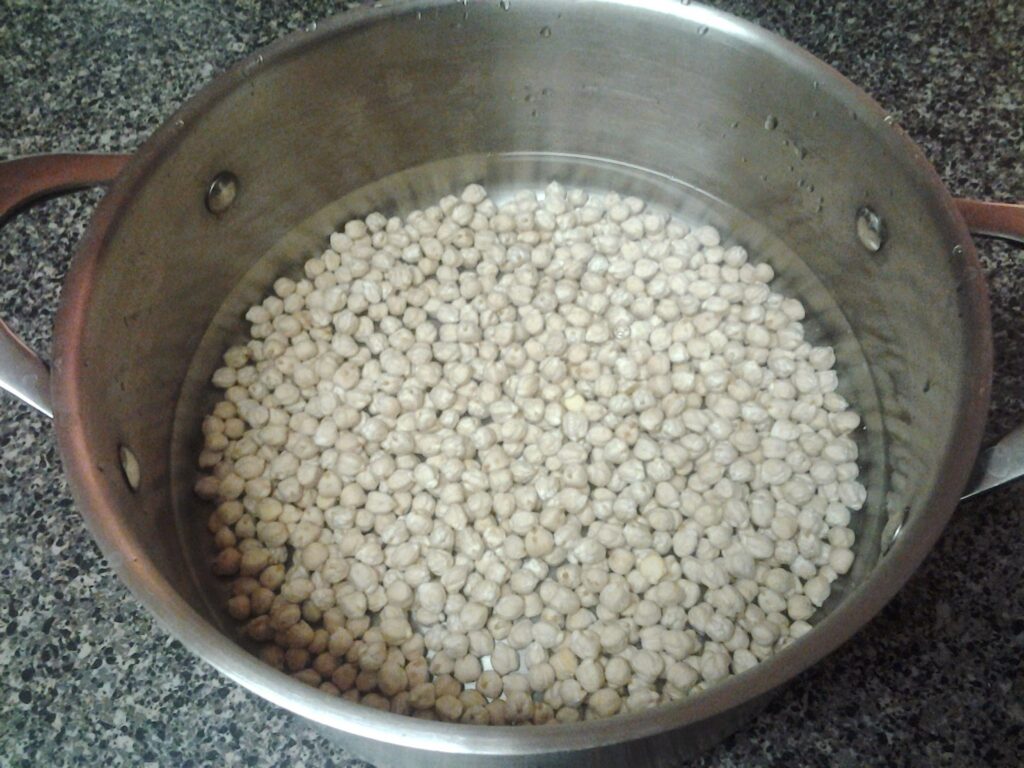
But before we go to the cooking part, you’d need to remove junk from the dried chickpeas. Dried chickpeas are sold in the open. So it may contain small stones, debris, dirt, etc. You’ve to check the beans for any junk and clear them out.
Once you’re done sorting through the chickpeas, gather them in a bowl and rinse them well with water. After cleaning them, soak them in clear water overnight.
After 8-10 hours, the chickpeas will become double the size it was when it was dry. Press them to see if they are breakable. If they are then it’s ready for cooking.
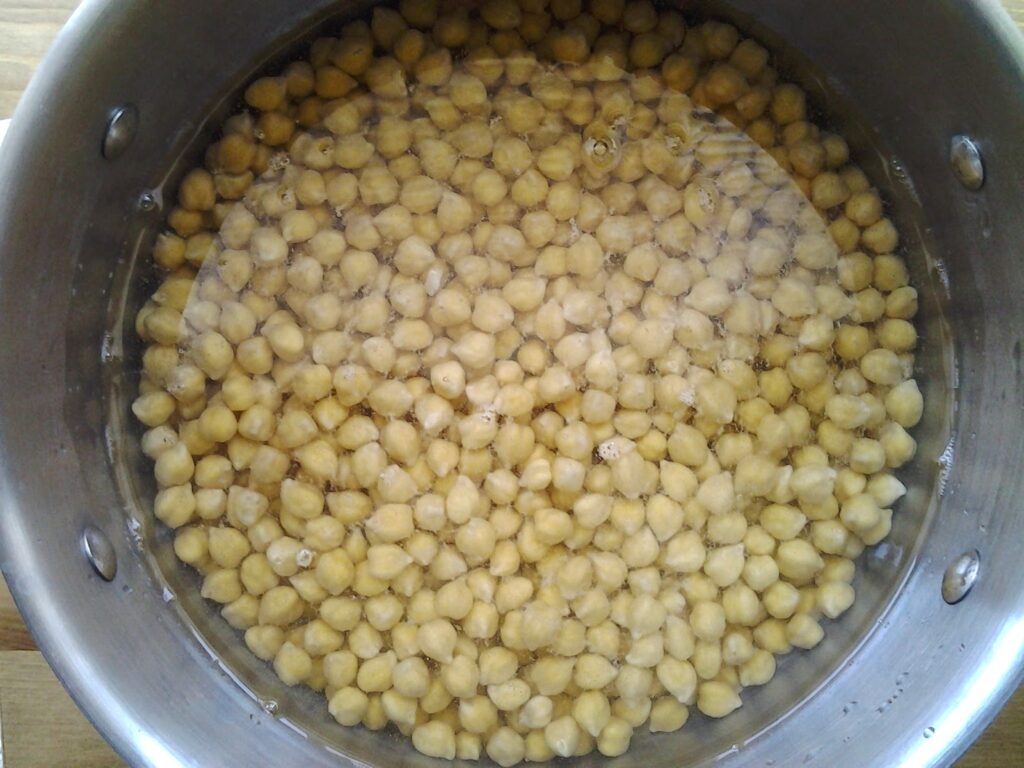
On the other hand, with canned chick beans, you don’t have to go through these steps. Since they are already hydrated enough in the cans.
Canned chickpeas have jelly-like consistency due to the bean juice. This bean juice is mixed with anti-nutrients, salts, and additives. Consuming these ingredients causes digestive problems.
So make sure to rinse them well with water and get rid of the bean juice.
Cooking Time:
The overnight soaked dried chickpeas need to be boiled for 45 minutes for them to become consumable. As for canned chickpeas, they are pre-cooked and pre-seasoned. Thus you won’t have to cook them again.
To cook the dried chickpeas, take 1 cup of soaked chickpeas and add 3 cups of water or broth.
Now start boiling them on the stove. Lower the heat to low-medium and keep simmering until it reaches the desired tenderness. Add more water if it seems they are still hard and keep boiling.
You can also use a Tupperware rice maker to boil the chickpeas. Once they become tender, rinse the water and set it aside.
Taste Differences:
Dried chickpeas have better taste compared to canned chickpeas as they are more flavorful than canned chickpeas.
Dried chickpeas have a nutty flavor which is more flavorful. They taste better with any recipe while cooked with the right seasonings.
On the other hand, canned chickpeas are less flavorful. That’s because it loses its flavor partially while being stored in the can for a long time. The taste comes out slightly mushy and metallic.
Proper Storage:
Dried chickpeas can be stored for about 2-3 years max if stored well at room temperature. In contrast, Canned chickpeas stay well as long as it’s unopened and haven’t crossed the expiration date. But they have to be stored in a cool and dry place.
Dried chickpeas need to be stored in a dry place. It’s advisable to use them within a year as the longer they stay the harder they become.
Chickpeas that are cooked can be stored in an airtight container for 3-4 days in the refrigerator. If it’s only soaked and uncooked then it’ll last about 4 days in the refrigerator.
Opened canned chickpeas, on the other hand, stay well in the refrigerator for 3-5 days.
Cost Comparison:
Canned chickpeas are comparatively more costly than dried chickpeas since they are processed and ready to use. Thus, at the same price, you can buy more dried chickpeas from grocery shops.
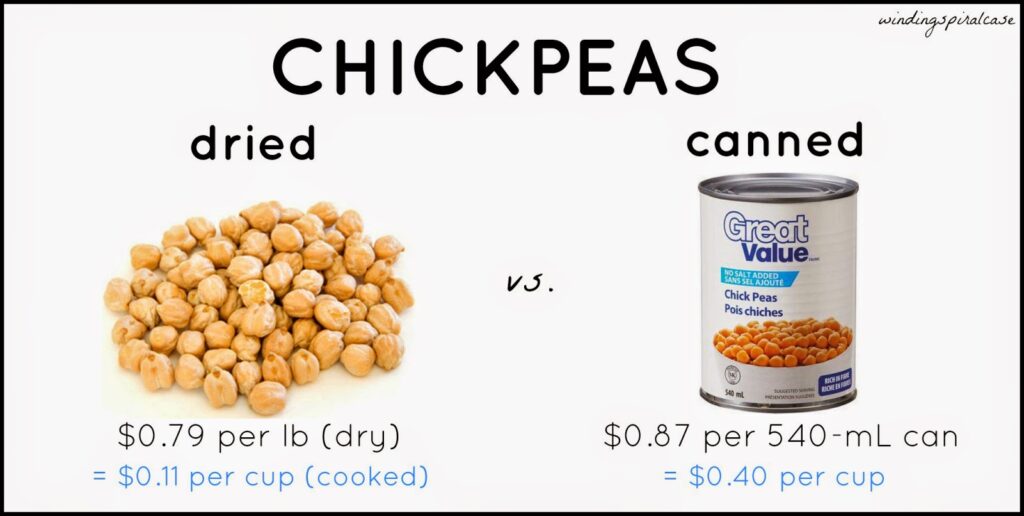
Nutritional Benefits Comparison
The main reason why dried chickpeas are better than canned ones is because of the nutrient benefits. Let’s compare the nutritional benefits of 1 cup of (200g) dried chickpeas with 1 can (253g) of canned chickpeas.
| Nutrition Facts | Dried Chickpeas (200g-1 Cup) | Canned Chickpeas (253g-1 Can) |
| Calories | 756 kcal | 352 kcal |
| Dietary fiber | 24g | 16g |
| Protein | 41g | 18g |
| Sodium | 48mg | 622mg |
| Calcium | 114mg | 114mg |
| Potassium | 1436mg | 319mg |
| Iron | 8.6mg | 2.7mg |
Dried chickpeas contain 756 calories per 200g cup, while canned chickpeas have 352 calories per 253g can. Dried chickpeas are also higher in fiber, with 24g compared to 16g in canned chickpeas. In addition, dried chickpeas have more protein with 41g compared to 18g in canned chickpeas.
However, canned chickpeas contain more sodium with 622mg compared to 48mg in dried chickpeas.
Both types contain 114 mg of calcium, but dried chickpeas contain more potassium (1420 mg versus 319 mg in canned chickpeas).
Lastly, dried chickpeas are higher in iron with 8.6mg compared to 2.7mg in canned chickpeas.
So, clearly, dried chickpeas are the best option.
Frequently Asked Questions (FAQs):
What are the health benefits of eating chickpeas?
Chickpeas helps to reduce blood glucose level. They also manage the blood pressure. It is good for bone health as it contains a good amount of calcium. It reduces cholesterol levels and helps to battle cancer. It also improves brain functioning, mental health, and digestive health.
Are chickpeas good for weight loss?
Yes, chickpeas are good for losing weight. It contains a good amount of fiber, protein, and other nutrients. The protein and fiber content promotes weight loss. It is not too high in calories either. You can experience weight loss faster if you eat them daily and do exercise.
Are canned chickpeas gluten-free?
Yes, like dried chickpeas, canned chickpeas are also gluten-free. It’s safe to consume for people with celiac or gluten-related disorders. However, it’s still better to check the ingredients mentioned in the can. If it contains wheat flour or wheat starch it might not be gluten-free.
Final Thoughts
So what’s your verdict about Dried Chickpeas vs Canned Chickpeas? Hoping it is dried chickpeas. Although the preparation and the cooking process take time and more effort, it is healthier than canned chickpeas.
Buy canned chickpeas only if you have an emergency or time shortage.
Happy eating!
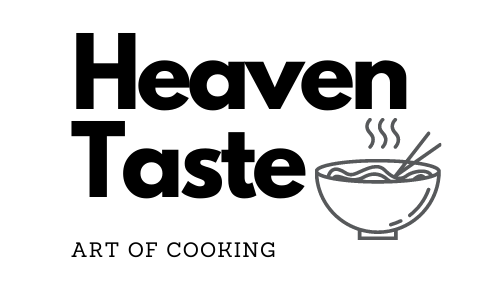
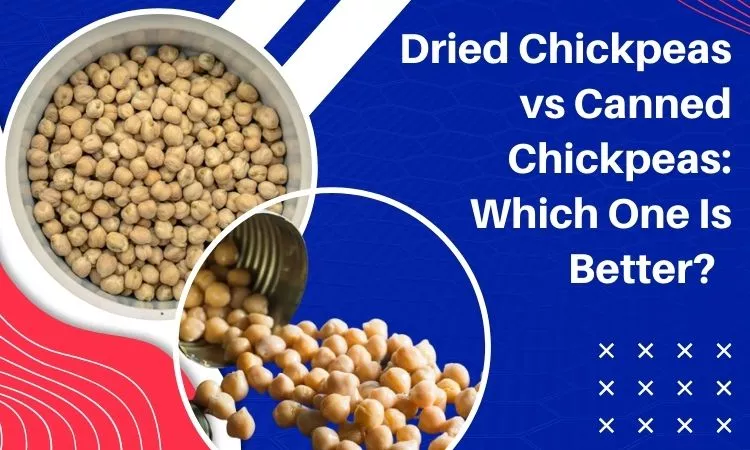
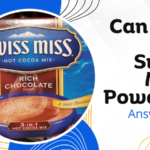



2 Comments